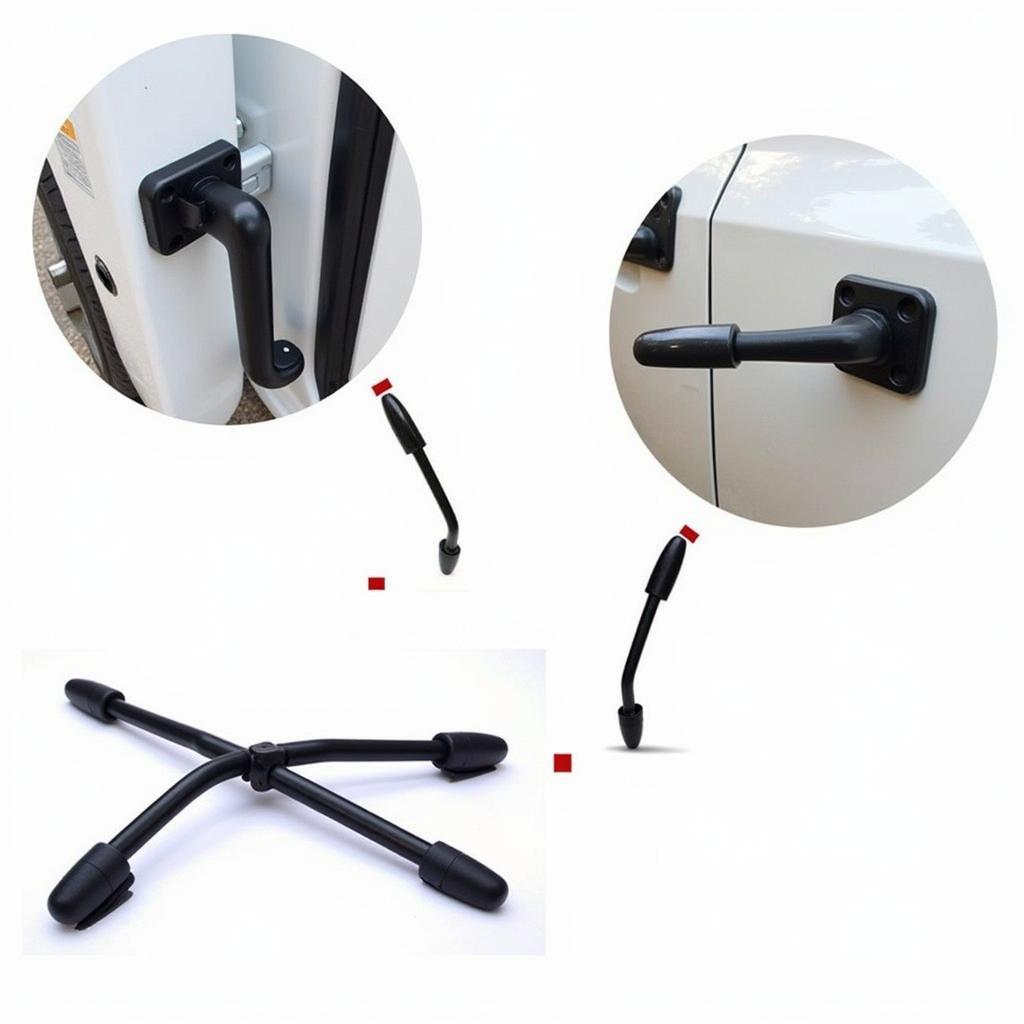Getting out of a car can sometimes be a challenge, especially for individuals with mobility issues. Fortunately, several assistive tools are available to make this transition smoother and safer. This article will explore a range of these assistive tools, from simple handles to more complex transfer boards, helping you regain independence and confidence.
Types of Assistive Tools to Get Out of Car
There are numerous assistive tools designed to aid individuals in exiting a vehicle safely. These tools range in complexity and functionality, catering to various needs and physical limitations. Let’s delve into some of the most common and effective options:
Car Handles and Support Bars
Car handles provide a stable grip and leverage, making it easier to pull oneself up and out of the car seat. These handles can be attached to the car door frame or the B-pillar, offering a secure point to hold onto.  Car Handles and Support Bars for Exiting Vehicle Some handles even swivel, allowing them to be tucked away when not in use. Support bars offer similar assistance, providing a sturdy handhold to aid in standing up. These are especially helpful for those with weaker legs or balance issues.
Car Handles and Support Bars for Exiting Vehicle Some handles even swivel, allowing them to be tucked away when not in use. Support bars offer similar assistance, providing a sturdy handhold to aid in standing up. These are especially helpful for those with weaker legs or balance issues.
For individuals who experience difficulty with the twisting motion required to exit a car, swivel seat cushions can be a game-changer. These cushions rotate, allowing the user to pivot their body and swing their legs out of the car with minimal effort. They eliminate the need for awkward twisting and reduce strain on the back and hips.
Transfer boards provide a stable bridge between the car seat and a wheelchair or other mobility device. These boards are particularly helpful for individuals who cannot bear weight on their legs. By sliding across the board, users can safely transfer out of the car without the risk of falling.
Other Assistive Devices for Exiting Cars
Beyond the common tools mentioned above, other devices can further enhance car exit accessibility. Leg lifters can assist those with limited leg mobility in maneuvering their legs out of the car. Inflatable cushions can raise the seat height, making it easier to stand. Even something as simple as a reacher grabber can be invaluable for retrieving dropped items or pulling the seatbelt. personal care tools for stroke patients to assist with showering
“Choosing the right assistive tool depends on the individual’s specific needs and physical limitations,” says Dr. Amelia Carter, a certified occupational therapist. “A thorough assessment by a healthcare professional is crucial to determine the most appropriate and effective solutions.”
How to Choose the Right Assistive Tool
Selecting the appropriate assistive tool requires careful consideration of several factors. First and foremost, understanding the individual’s specific mobility challenges is essential. Factors such as strength, balance, and range of motion play a significant role in determining the best tool. The type of vehicle also matters, as certain tools are better suited for specific car models.
Consulting with an occupational therapist or other healthcare professional is highly recommended. They can assess the individual’s needs and recommend the most suitable assistive devices. acute care fall risk assessment tool Furthermore, they can provide guidance on proper usage and ensure the chosen tool is safe and effective.
Maintaining Independence with Assistive Tools to Get Out of Car
Assistive tools are invaluable for maintaining independence and improving quality of life for individuals with mobility challenges. By facilitating safe and easy car exits, these tools empower individuals to participate more fully in daily activities and maintain social connections. personal care participation assessment and resource tool “Regaining the ability to get out of a car independently can be a significant boost to self-esteem and overall well-being,” adds Dr. Carter. “It allows individuals to maintain their autonomy and engage in activities they enjoy.”
Conclusion
Assistive Tools To Get Out Of Car offer a valuable solution for individuals facing mobility challenges. From simple handles to more complex transfer boards, these tools can significantly improve safety and independence. By carefully considering individual needs and seeking professional guidance, individuals can find the right assistive tool to regain confidence and mobility. Remember to explore options like car handles, swivel seats, and transfer boards to enhance your car exit experience. technological tools used in long-term care
FAQ
- What is the most suitable assistive tool for someone with limited leg strength?
- Are car handles universally compatible with all car models?
- Where can I purchase assistive tools to get out of car?
- How do swivel seat cushions work?
- What are the benefits of using a transfer board?
- Can assistive tools be used for both entering and exiting a car?
- How much do assistive tools typically cost?
See also: tools for elderly care
Need assistance? Contact us via WhatsApp: +1(641)206-8880, Email: [email protected] or visit us at 910 Cedar Lane, Chicago, IL 60605, USA. We have a 24/7 customer support team ready to help.

Leave a Reply